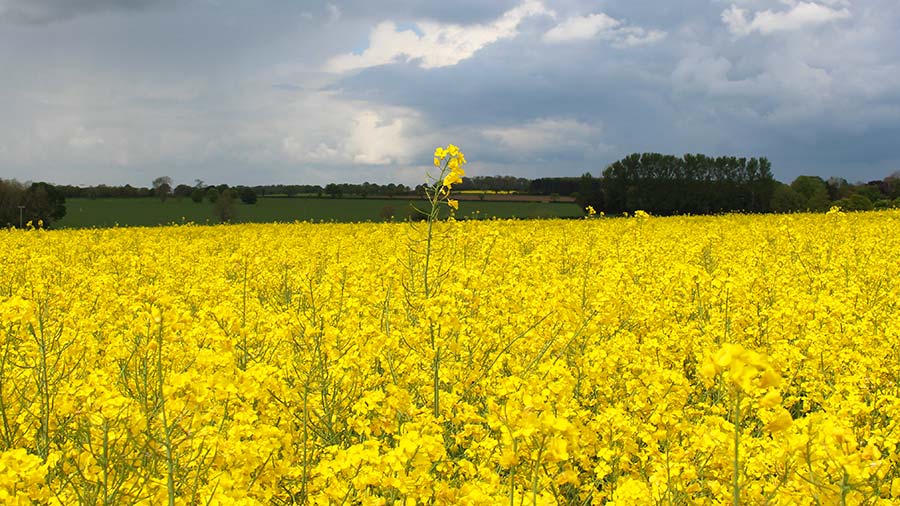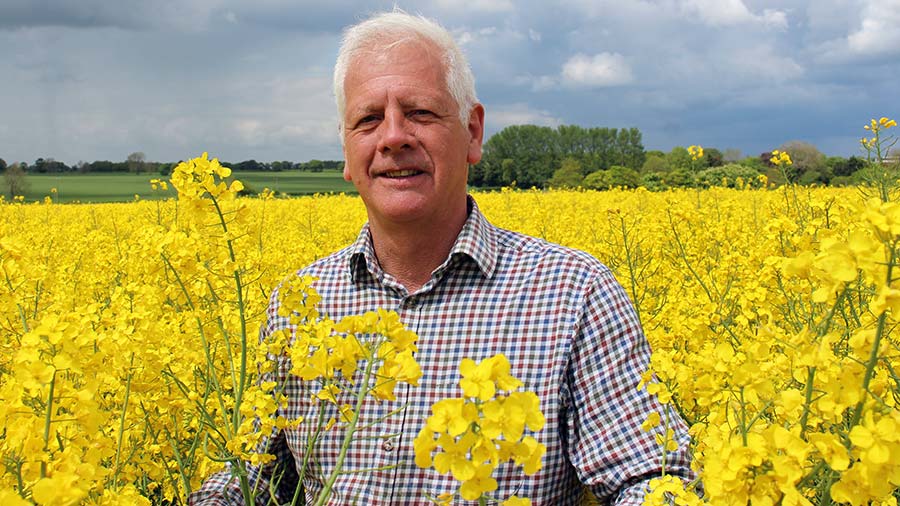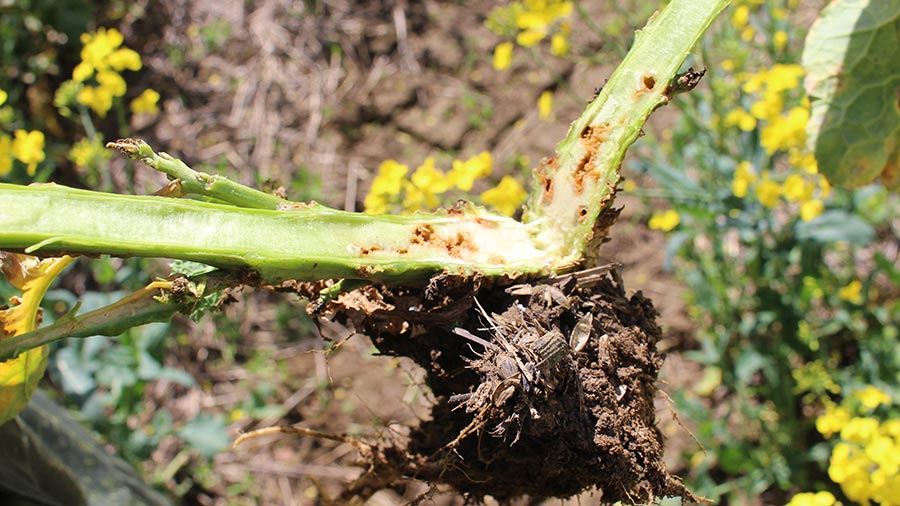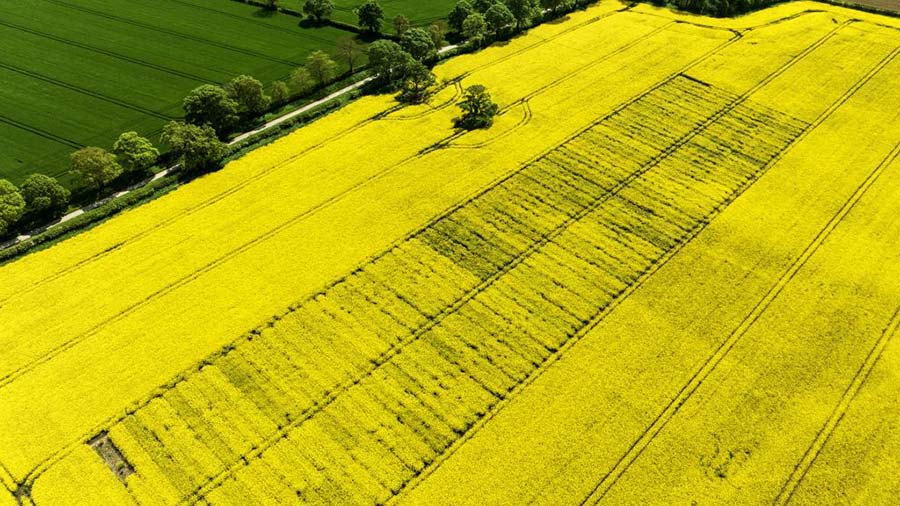How OSR variety choice helps crops survive flea beetle
 © MAG/Richard Allison
© MAG/Richard Allison Simply selecting the top yielding OSR varieties on the AHDB Recommended List is not always the best approach in high cabbage stem flea beetle areas, according to Agrii trials and farmer experience.
Results suggest hybrid varieties with the right growth habit are most likely to survive the adult threat in late summer and larval infestations in the following spring, and deliver a good yield.
Consequently, two of Agrii’s four bestselling varieties are no longer on the AHDB Recommended List (RL), but have proved themselves in the company’s variety trials.
See also: Variety blends: Do they work in oilseed rape?
Agrii technical manager David Leaper explains that the RL is designed to show varietal potential and therefore, is focused on yield.
“In contrast, we are focused on other characteristics and growth habit is a key one for flea beetle.
“For example, has it got the speed to grow away from the flea beetle larvae threat in spring?” he says.

David Leaper © MAG/Richard Allison
There is trial evidence suggesting that early vigorous growth habit can offset the damage cause by feeding larvae.
Furthermore, Agrii’s trials are more representative of on-farm practice using a commercial approach to disease control and seed rates.
They are drilled at 50 seeds/sq m for hybrids and 70/sq m for conventionals.
The current four top varieties are:
- Ambassador
- Auckland
- Exsteel
- Inv1035.
Of the four, the latter two are no longer on the RL, but account for half of sales, he says.
“Exsteel has consistently been in the top five best-performing varieties every year for the past seven years across 40-45 plots. It has always been up there.”
It is consistently one of the most vigorous hybrids in the autumn and quick to move away in the spring.
“Trials have shown it is one of the best varieties to cope with cabbage stem flea beetle larval infestations.”

Cabbage stem flea beetle larvae in oilseed rape © MAG/Richard Allison
Current season
Trials to identify performers in flea beetle situations are ongoing, as new varieties come forward from the breeders.
This year, they are being severely tested by larvae at the Lincolnshire site, near Revesby.
The first assessment is the late autumn biomass score. This looks at how bulky the crop is. “Is there good ground cover or are they looking sad and thin?” says David.
Having bigger plants can help save on nitrogen fertiliser, but, importantly, they are more resistant to harsh winter weather and help cope with larval damage, he explains.
In 2023, Ambassador topped this, followed by Aviron.
At the end of February, plots are assessed to look at increased apparent bulk.
In mid-April, assessments were carried out for cabbage stem flea beetle and stem weevil larvae counts, with plenty being found.
Plots ranged widely with the worst one having 80% of plants showing visual damage.
The lowest saw much less damage at 40%, which was the candidate variety Kanzzas.
Finally, plots were assessed at flowering using a drone to measure differences in biomass.
Early results suggest that hybrids are outperforming conventional types due to their increased vigour.

The oilseed rape variety trial plot in Revesby © Andrew Watts
“Conventionals are looking at bit off pace,” he says. There are also differences within the hybrids.
David believes some of the newer Limagrain varieties, such as Aviron, could be a successor to Aurelia, which is looking a bit weak on stem health.
Another potential is Auckland, which has a slightly faster autumn growth habit and is slightly quicker to grow away in spring.
It also shows reduced symptoms of verticillium wilt compared with Ambassador.
Some other high-yielding newcomers are, however, suffering a hit with flea beetle larvae on the site, and he expects this will dent yields.
“While it is only one site, it confirms what we have seen in previous years that growth habit is crucial.”
Looking further ahead, one candidate variety that has caught David’s eye is RAGT’s Kanzzas, which has the lowest count for larvae.
“It is a bigger plant and it dilutes the damage. I suspect it will do well on this site this season.”
Plots will be taken to yield, and results will help drive variety recommendations going forward.
What about the 2023-24 area?
Agrii’s David Leaper says that the company’s OSR seed sales this season have hit 55,000ha, continuing the upward trend since 2020.
He believes this increased activity is due to the higher commodity prices.
However, he sees next season’s sales being moderated by this year’s experience and predicts that the area will either plateau or slip back a little for the 2023-24 crop.
One clear trend is the move to hybrids, having risen from 75% of sales to 85% in the past three years, and the conventionals’ share being squeezed.
He thinks the compensation schemes introduced by various breeders has given farmers a little more confidence to invest in seed.
Farmer experience: Peter Cartwright, Revesby Estate
Variety choice has been a key part of Peter Cartwright’s strategy against cabbage stem flea beetle at Revesby Estate.
He says that oilseed rape yields were heading to 5t/ha six years ago and then it crashed, due to cabbage stem flea beetle.
“We used to grow Holl [high oleic, low linolenic acid] and it fell to 1.7t/ha.”
Yields have gradually risen and the Aurelia averaged more than 3t/ha last year.
He plans to widen the rotation from one in six to one in seven next year for the rapeseed.
One key flea beetle measure is not having brown bare soil.
He recalls a couple of years ago there was combine fire that burned off the stubble in a patch before being drilled with OSR.
“To the line, you could see the area destroyed by CSFB [cabbage stem flea beetle], and in the rest of the field, the damage was less severe with a reasonable yield. This was an eye opener.”
So he now leaves as much ground cover with longer stubble and chops straw where possible.
Selecting the right variety is key and he goes for those with good vigour.
Aurelia is his mainstay with its early vigour, along with Ambassador and Auckland, which have performed well in Agrii trials at Revesby.
Also a specialist protected phosphorus and potassium starter fertiliser, Agrii-Start Release, is put down the spout at drilling to help with establishment.
“One year, the drill played up with seed in the front hopper and fertiliser in the back spout, and we went up and down (the field) a few times before realising the back spout had blocked.
“We saw big differences in the canopy development of the plants that didn’t receive the starter fertiliser.”
He says this difference carried though to green area indices the following spring and yield.
One future measure is the use of a continuous clover cover. “We tried before and while it did suppress weeds, it also suppressed the wheat being a bit too aggressive.
“The following spring, when drilling beans, we had to spray it off and abandon drilling due to the ground being too dry.”
In the following season, where the clover was, the oilseed rape looked bigger and there was a 0.8t/ha difference.
He believes this is due to the residual nitrogen when establishing the OSR.
“So we are going to have another go.”

